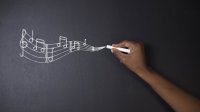Music as a Teaching Tool
Incorporating music into almost any class can be a great way to teach content—and it doesn’t take special training or expensive resources.
Your content has been saved!
Go to My Saved Content.Many teachers shy away from including music in their classrooms because they presume they need musical training to use music as a teaching tool. However, there are multiple ways to implement music in the classroom that don’t require any training.
Classroom Strategies
In the early grades, transitions are a little harder to set because the students are still learning what the concept of a minute is and what one feels like. A song can improve transitions because it becomes a behavior cue: Students grow accustomed to the length of the song or part of a song and internalize the time they have to move on to the next task, which helps them begin to take responsibility for their own learning.
Many of us know that music will get you up and moving. Using songs for movement is a great method to provide students with a brain break, especially in the younger grades. There are many resources already available to help create educational brain breaks that don’t disturb classroom management, such as GoNoodle.
Students with physical impairments can benefit from listening to music because doing so helps with concentration and/or influences their movements. Smooth music will result in movements with a flow, while fast dance music may cause jerky movements.
Social and emotional skills are learned everyday by students as new scenarios present themselves. Try teaching them skills through songs. An example is taking the tune of “Hokey Pokey,” which is familiar to most children, and adapting the lyrics to talk about how to calm down from a stressful situation, as in this version adapted from Margie La Bella’s Music Therapy & Education:
You take a big breath in,
You take a big breath out,
You take a big breath in,
And again you let it all out.
You can focus on your breath.
You can learn to calm down.
That’s what it’s all about.
As educators, we want to appropriately challenge each student—encouraging higher-order thinking while meeting state standards. Music is one tool to engage each student and provide a pathway for connections and deeper understanding. Songs are essentially poems, and have a lot of meaning packed into few words. Questions arise as to what the author means, students’ own experiences are considered from the perspective of that meaning, and this helps create an environment where students will want to share what they are thinking and why. This leads into a personal drive to do research to understand what the author is referring to in the lyrics.
Here are just a few examples of ways to incorporate music into your classes:
History is a subject that benefits greatly from having music as a lens to teach about cultural traditions and historical events. For example, the Dust Bowl can be taught through songs by Woody Guthrie and/or Benny Goodman, with students analyzing the conditions people lived in at the time.
Mathematics can be challenging for students to understand because the concepts are abstract, which is the main reason it’s important to provide visuals and manipulatives to students when first teaching a concept. Musical notes can help teach fractions, changing instruments but playing the same song can help teach patterns, and using pitch can help with frequency and ratios.
Science can benefit from songs that teach about the skeletal system or incorporate mnemonics to help students remember the food chain. Music can be the content for teaching about sound waves and having children experience frequency with relation to pitch.
Literacy improves when a student is able to pick up on the patterns in the structure of language and is able to differentiate between pitches in words that sound similar but have different meanings. Music can be utilized as a metaphor to explain elements of a story such as character, setting, conflict, and resolution, using the melodies, instruments, tempos, and dynamics as the teaching lens.
Working With Limited Resources
You don’t need a lot of expensive supplies to incorporate music into your class. Here are a few ways to bring music into your class at little or no cost:
- Create a CD or playlist of songs to use for motor skills, academic, or relaxation time.
- Make instruments out of recycled materials. A guitar can be made from a cereal box, drums from cans and plastic bottles. KinderArt provides simple yet creative ways to make instruments that can also be used to discuss cultures. And Music in Motion provides a great list of instruments that you can make from recycled materials or buy from the website.
- Clapping, snapping, tapping, whistling, humming, and stomping are great ways to make music. For ideas on how to start music simply by using your body, check out the musical Stomp—for example, the part of the show in which clapping is the main instrument.
- Post anchor charts to refer to for specific dancing songs or yoga positions.
